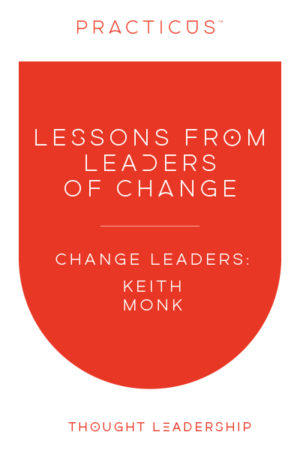Lessons from leaders of change: Keith Monk
In this series, we interview a respected change leader to discuss the successes and hard lessons that made them who they are today. This month, it’s Keith Monk, an executive who has made a mark across retail, regulated, engineering, manufacturing and financial sectors – driving culture change and technology transformations to advance business growth.
Keith Monk, Transformation Director
Have you ever asked yourself whether business could one day become pure science? We find ourselves on the crest of a data revolution where analytics and vast quantities of data and computational power are colliding to shape the world around us and create new business thinking.
The last few years have seen a massive transition from expert judgement to data-driven decision making. Keith is a leader who is passionate about how technology can better the lives of customers and has dedicated his professional life to technology-enabled business growth. From transforming the customer experience to driving organisational efficiency, it has all been about making more informed business decisions based on real, up-to-date information. But unlike some of the advocates of this completely logical world, he’s also keen to highlight the many dangers.
“We have this desire to automate everything and a belief that if you follow the best practice framework then success can be the only consequence,” he says. “But it doesn’t work like that. There is a science to business change but it is also an art and, if you look at medicine and many of the other areas we expect to be totally scientific, you’ll find there is art there as well.”
Lesson 1: Method aids success
but doesn’t guarantee it
Keith’s comparison with medicine is not incidental. Alice, one of Keith’s daughters, had Rett Syndrome. This is a neurological condition that most often strikes girls between their first and second birthday and leaves them with multiple disabilities and medical complexities for life. Alice sadly passed away aged 14. It’s a complicated condition and Keith and his daughter spent a lot of time in hospital being helped by medical professionals. What he discovered was a world quite different to the one he expected.
“I’m a positive person,” says Keith. “There is no cure for Rett Syndrome, not yet, but Alice had related complications that were well understood and treatable. At first, I was often impatient that doctors could not immediately determine the best course of treatment, instead there were always different options. If you spend a lot of time in hospitals, it can be frustrating but you don’t always fully appreciate what’s going on behind the scenes.
“Good doctors and specialists don’t assume certainty purely from what the scientific literature says. They make observations, get curious and think. They draw on their experience and, most importantly, they’re not afraid to ask other people to draw on theirs and discuss it, to get the fullest and most up-to-date picture possible. Choosing the best course of treatment is not formulaic instead it requires skilful judgement.
“The comparison may seem odd but we see similar situations within business change. Change, just like medicine, is human, complex and interconnected and therefore not uniformly consistent or predictable. Methodologies and text books would have you think that business change is a science and it’s replicable by following the processes. There is some great literature out there based on solid research and experience. But just like in medicine, simply following the text books alone does not guarantee success – great teamwork, observation, communication, judgement and balance is needed in addition to following the method. I believe it pays to be curious. It pays to hire people who are curious. Things are not always as they appear, despite everyone’s best intentions. You develop an instinct, an antenna, for things that should be followed up even if they are seemingly trivial. There’s no methodology in the world to teach you when to do this.”
Lesson 2: Stakeholder management
is about growing relationships
One thing you can’t underestimate in either business change or medicine is the value of excellent interaction during challenging times.
“An example would be a programme I led across a large group of companies to change core processes and systems,” says Keith. “Midway through the £40m programme, one of the companies decided to re-organise from a regional to a global business model. The easiest decision would have been to take the company out of scope given the uncertainty that a business-wide re-organisation brings and the commercial risks of re-engineering key processes at the same time. I pursued the harder option to keep them in scope as it would have the best overall outcome.
“Situations like this challenge even the strongest relationships. The board was investing considerable leadership focus, energy and expense to change the business model and keeping them in my programme would complicate their plans. Tensions were running high, personnel in regional operations would have to centralise to a new location or face redundancy, and these were the very people whose processes and systems needed to be incorporated into my programme.
“It takes courage and strong stakeholder management to get the right thing done. And it was by building trust and working with staff at all levels that the right things ultimately happened. There were many positive outcomes to doing that but perhaps the most readily appreciable is that it meant protecting trading transactions from Day 1 that would have otherwise been at risk.
“I’ll try and illustrate the difference when I got it wrong. A few years ago, I led a programme to implement SAP in a large energy company. At the time, organisations were getting a rough ride in the press for implementing SAP poorly. There had been a particularly high profile failure at a local authority and it had people worried.
“We won support for a low-risk approach amongst executives and senior management in the company but it meant that SAP would only be tailored by exception, other processes would be vanilla SAP. Then a colleague and I received an invite to the monthly power station managers meeting. Ah! It’s not that we hadn’t identified them amongst our stakeholders, or even that we hadn’t been communicating with them to sell them the benefits. We had. It’s fair to say though that we knew the meeting was going to be a rough ride because this approach would affect them significantly. And, yes – it was rough.
The lesson was to immediately invest far more energy to intensively build relationships to these stakeholders, visiting power stations and meeting face to face. A month later we were back at the managers meeting for what could have been another bruising. But there was no more anger – the questions were constructive rather than confrontational.
“They had been right to challenge and protest previously and it reminded me again that stakeholder management isn’t about a mechanical communications plan but it is always about relationships and engaging with people’s emotions.”
Lesson 3: overcome the project paradox
Keith is a big believer in what he calls, “Being really clear on the three Os: Objectives, Outputs and Outcomes.”
“A big mistake,” he says, “would be to focus too much on the outputs of a change initiative and miss out on the outcome. The operation was a success but the patient died to use another medical analogy. You can become too focused on getting things over the line. You equally need to focus on the reason why it is important and the problem is that the business world doesn’t stand still.
It’s almost a paradox to hear Keith describe it, “To deliver successfully on a project you need to be selfish and focus on what needs to be delivered and remove obstacles. But at the same time, you need to be aware of everything that is going on around the project and generous around changing the project to fit with the emerging picture. You want to control scope but equally, if you keep it too tight then you’re likely to end up missing the intended outcome and delivering something that is of no use. I’ve always believed in doing the right thing, even if that’s the harder thing to do.
“An example would be an organisation-wide programme I led to achieve compliance with a new regulatory regime Treating Customers Fairly (the first “O”, the objective). Eight programme workstreams were designed – including leadership, colleague engagement and ways of working – to drive and assure delivery (the second “O”, the outputs).
“Throughout the programme, it was essential to consciously review that the planned programme objective and outputs were going to embed a sustainable outcome, in this case delivering fairer outcomes for customers (the third “O”). Remaining mindful of the three Os, we challenged ourselves throughout the programme. It became clear that compliance was not the sole objective but that Treating Customers Fairly also described how we strategically wanted to do business. So we extended the objective to include that and added an additional output, namely agreeing among Board members how to prominently align Treating Customers Fairly to the business strategy.
“In fact, the objective, outputs and arguably the outcome for customers all changed during the 18-month programme – something that would never have happened if we had selfishly focused on getting activities over the line. Instead a more appealing and sustainable outcome was targeted and achieved through a cultural transformation – a shift from being told to do something to wanting to do it.”
Lesson 4: A culture of transparency
depends on trust
Keith is a big believer in transparency. It’s vital in building trust and delivering change successfully. He stresses that project and change management, as the name suggests, is management:
“Good management is applicable across both operations and projects. You must cultivate an environment of honesty and trust where everyone feels willing to tell you something you might need to know. Without this, people will start to hide things from you, meaning you might find out when it’s too late. It’s rarely a recipe for success. I believe passionately in taking away this temptation but at the same time making everyone feel they have their skin in the game.
“An extension of that is that you equally need to be open and feel comfortable with asking for help when you need it. I remember being hired for a programme because I’d previously implemented the technology somewhere else. This was being misunderstood internally and I was being hailed as some kind of technical guru. They got a surprise in the first team meeting. People would ask really detailed technical questions. I would say, ‘I don’t know the answer to that but I’m glad you’re wanting to ask it. If it is that important to you, it should be important to me too.’ The initial reaction was, who the hell is this guy? He’s supposed to be the expert! The important thing was I followed through and found people within the team who did know the answer. Within a few sessions, people understood: it’s ok to not always know the answer so long as you’re open about it, have the right team to turn to and do something about it. It signalled that trust is built through honesty rather than pretending to know it all and that we were all in it together.”
Lesson 5: If you start a project well,
you finish it welL
If the project is the patient and the need for change is the ailment, then early intervention is vital. “Take organisational change programmes as an example,” Keith says. “With accountability for designing and implementing a new target operating model, it is essential in my experience to recognise from the very start that staff often feel frightened and unsettled by such change. You have to engage with them early to set the right tone – recognising their feelings, being as open as possible and standing up in front of them to explain what the change is and why it is needed. Many of the challenges you face down the line with business change are more easily overcome by having started well. The better you start a project, the better you finish it.
“Starting well also means getting the project team right. Even a great project manager with a poor team will fail. A poor project manager with a great team may also fail but probably stands a better a chance of success. The team is critical and if you think you need to make changes to it, it’s best to do it all at once and as soon as possible.
“There’s no book to guide you through each and every challenge you will face. I don’t think that book can be written. Every business change situation is unique. Yes, there will be parallels, yes there is broad guidance that can be given. But I challenge anyone to say there’s an all-encompassing approach that guarantees success. It’s your experience, your artistic as well as your scientific mind and, of course, those of your team too that will see you through to success, just as much as the methods.
“The scientific world knows this. Right now, there are laboratories that have proven Rett Syndrome isn’t the irreversible condition we all thought it was. One lab in particular has developed a new method for reversing the disease in mice at a very late stage – showing it to be one of the only neurological disorders in the world that can have dramatic reversal. This approach could be used in principle to develop a treatment for humans. However, the team at this laboratory are modest about the fact that any successful treatment will depend upon support and collaboration with other laboratory experts in Rett Syndrome. It’s this blend of method, teamwork and experience that delivers progress.”
You can find out more about Rett Syndrome by visiting reverserett.org.uk
If you have a particularly challenging change agenda, please contact Practicus on 01491 577122





0 Comments